95????? ?????? ???_??
- 1. ???????? The Journal of Korea Open Associ?ion for E¦ÁIy Childh¡Şd Educafion 2000. 11. Vol 5. No. 2, pp. 45 - 70. ??????? ?????? ??? ?? ? ? ?* ??? ?????|? ??? ?????I? ??? ????? ???| ??? ??? ? ??? ? ?? ??? ??? ?????? ?????? ??? ?O?}?£¬ ?? ???? ? ?????| ??? ??? ?? ?????? ?!????£¬ ??? ??? ???? ??01 ?? ?????? ???? ??? ??? ???? ???? ??? ? ??? ?????? ?? ?????? ????? ??? ????? ?? ?? ?£¬ ?? ?QI? ¡®????.?l ?? ??? ??? ?? g?? ???1M? ????? ???? ??? ??? ?of????? ??? ??? ???? ????? ???? ??????? ? ????? ?????? ????? ???????? ?? ??? ???? ? ???¡® 0101 ????? ?? ???? ? ??? ???? ?? ???? ???? ??? ????? ???? ? ? ????? ???? ? ??? ????? ????£¬ ????? ??? ??? ???? ????? ?????? ??? ??? ??1. ? ? ??g? ?????|? ???? ????£¬ ????? ? ??? ??? ???? ??? ????? ???? ?Of??ii1li??| ??{? ????? ?!Cf 1. ? ? ?? ?? ????? ?? ??? ???? ?? ????? ???? ??? ???? * ????? ??
- 2. 46 ???????? (? 15? ? 12 ?) ??? ?????? ??? ????£¬ ??£¬ ???? ? ????? ??? ??? ?? ?????? ???? ??{F1ohr £¬ 1996; Frost, 1998; H?den£¬ 1997; Jensen, 1996; Jones, 1999; Jones, & Field, 1999; ¦Ìng£¬ 1999; Rauscher, et ?£¬ 1993; sc?aug£¬ 1995; Wilcox, 2000). ??? ? ?? ?????? ??? ??? ???? ??? ?? ?????? ???? ??? ? ?? ???? ???? ?? ???? ??. ??? ? ?? ?????? ?????£¬ ??? ?? ???? ???? ????? ? ? ????? ???? ???? ??? ???? ?? ??? ??? ??? ??? ?? ?? ?? ???? ????? ????? ?? ??? ? ?£¬ ??? ???? ????? ???? ?? ??? ? ?? ??? ?? ?? ????? ??? ??? ???? ?? ? ? ??? ???? ??? ???? ??? ?? ?? ???? ?? ??? ???? (Weinberger, 1998a, 1998b) ??? ??? ?? ??? ???? ??? ??? ?? (processing)? ??? ??? ??? ???? ??? ????? ???? ??? ???? ? ? ? ??. ?? ??£¬ ?? ?? ??? ? ?? ???? ???? ???? ? ?? ?? ?? ??? ??? ????£¬ ??? ??? ???? ?? ???? ??? ??? ????? ??. ??£¬ ???? ???? ????? ?? ??? ???? ???? ???? ?? ?? ?? ????? ??? ???? ??. ??? ??? ?? ????? ??? ??? ?? ? ???¡µ ??£¬ ??£¬ ??£¬ ?????? ?? ?? ¡¤ ?? ??£¬ ??£¬ ??£¬ ??? ?? ????£¬ ??? ? ???? ?? ¡¤ ??? ?? ?? ??£¬ ??? ?? ??? ???£¬ ? ????? ?? ??£¬ ?? ?? ??? ??? ??? ???£¬ ????? ? ??? ? ???? ?? ???? ??{Sergem£¬ 1992; Weinberger, 1998a, 1998b, Zatorre, 1992) ? ?? ?? ??? ???? ???? ?? ??? ?? ??? ???? ??? ?? ? ?? ??? ???? ??? ?????. ?? ???? ?? ???? ????? ?? ? ??? ???£¬ ??? ???? ???? ???? ???? ??? ?? ???? ? ?? ??? ? ???? ??? ??£¬ ??£¬ ?? ??? ??? ????? ???£¬ ??? ????? ??? ??? ????? ???? ??? ??? ???? ???? ???? ?? ??? ?????? ??? ??? ????? ??? ???? ?? ??? ?? ? ?? ??????? Sergem( 1992)? ??? ???? ???? ??- ?? ?? ??? ?????? ??? ??? ??? ????? ???? ??? ?? ? ??? ????? ??? ???? ????? ??? ?? ?? ??? ????? ? ?? ?? ??? ??? ?? ???? ??? ???? ?????£¬ ??? ??? ??? ? ??? ?????? ??? ???? ?????? ??? ???? ????£¬ ??£¬ ?
- 3. ??????? ???¼º)?? ??? ?? 47 ?????? ???? ??? ??? ???? ??? ?? ????? ??? ??? ? ??? ??? ?? ??? ?????? ??? ?? ?????? ???? ??? ?? ?? ??? ???? ??. ??? ????? ?? ????£¬ ?? ???£¬ ????£¬ ?? ? ? ??? ??? ???? ???£¬ ???? ? ?? ???? ???? ???? ?? ? ? ??{Weinberger£¬ 1998b) ??? ??? ???? ??? ???? ????? ? ?? ??? ???? ???? ???£¬ ????? ??£¬ ?? ? ?? ???? ??£¬ ??£¬ ? ?£¬ ??? ?? ???? ??? ????£¬ ? ?? ????£¬ ????£¬ ????£¬ ???? ? ?? ????? ??? ????? ????£¬ ?? ¡¤ ??? ??? ?? ??? ?? ? ?? ?? ????????suggestopedia)? ???? ??{Bancroft£¬ 1999; DePorrer, & Hernacki, 1992; DePorrer, Reardon, & Singer-Nourie, 1999; 1¦Ñzanov£¬ 1978, 1979; Reimer, 1999; S?ffier£¬ 1992) ??? ??? ????? ??????? ??? ??? ???? ???9 ?? ? ?? ?? ?? ??? ???? ???? ?????? ??? ????? ??? ??? ?? ??? ?????¡® ??? ??? ??? ??? ????? ???? ???? ??? ? ?? ???? ???? ?? ??? ??? ?? ? ?? ?? ???? ??? ???? ? ???? ??? ????? ?????£¬ ???? ??? ????£¬ ??£¬ ?? ??? ?? ? ??? ? ?? ???. ??? ??? ?????? ????? ????? ??? ?? ????? ??? ? ?? ??? ?? ???? ?? ?? ?? ?? ???? ?? ??? ??? ??? ????? ???? ??? ???? ?? ?? ?????? ?? ??? ?????? ??????? ?????? ??? ????? ???? ??? ?????? ??? ?? ? ???? ??? ?? ¡¤ ???? ???£¬ ??? ¡®????¡¯? ?? ??? ??? ?? ????? ????? ???? ??{???£¬ 1998, 4-7, 21, 1999, 41-45, 86; ??????£¬ 2000, 31) ?? ???? ???? ?? ?? ????? ?? ? ? ??? ?? ??? ??? ???? ???£¬ ??? ??? ??? ??? ?????? ??? ???? ??? ? ??? ?? ??????? ?????? ??? ? ??? ? ???reinberger£¬ 1998a) ??? ??????? ??????? ?? ???? ????? ???????? ?? ??? ???? ????£¬ ?? ????? ?? ???? ? ??? ???? ?? ??? ? ???? ??? ??? ???? ???? ? ? ????? ???? ? ??? ?? ? ???? ?? ?? ? ????? ????? ??? ??? ???? ????? ?? ???? ??? ??? ??£¬ ?? ???? ????? ??? ????? ?????? ? ?????????? ??? ???? ????£¬ ????? ? ??? ??? ??? ? ??? ????? ???? ????? ??? ????? ??
- 4. 48 ???????? (? 5? ? 2 ?) II. ???????| ??? ?? 1. ?m???? ??? ?? ??? ??? ????? ???? ??? ?? ???? ??? ??? ???? ?? ?. ??? ??? ?? ??? ??? ???£¬ ???? ?? ?? ??? ??? ???? ??? ?? ?????. ??? ?? ??? ??? ?? ??? ??? ????? ?? ??? ??? ????? ??? ??? ??? ????? ??? ?? ??? ??? ? ???? ??? ??? ??? ??? ??? ??? ???£¬ ??? ?? ??? ???? ??. ?? ??? ??? ??? ?? ?? ?? ?? ?????? ??????. ??? ??? ???? ??? ??? ??? ?? ?? ??? ??? ??? ??? ? ???? ?? ??? ??? ???¡´???£¬ 1996) ?? ???? ???? ??? ??? ?? ??? ???? ?? ??? ?? ?? ? ??? ?? ??? ????? ???? ??? ???£¬ ???? ??? ?? ??? ? ?? ?????? ??£¬ ??? ??? ????£¬ ??? ??? ?? ??? ????. ? ? ??? ???? ?? ????? ??? ?? ?? ???? ??? ??? ??? ? ? ????? ??? ?? ?? ????? ??? ??{???£¬ 1997). ??? ?? ?? ?? ??? ?? ????? ?? ?? ????? ??? ?? ?? ?£¬ ????? ???? ???? ?? ??? ???? ??? ??? ?? ???? ? ?? ???? ??? ??? ????? ???? ???? ? ?? ??? ??? ?? ????? ?? ???? ?? ?? ?? ? ????? ?? ??? ?? ??? ??£¬ ??£¬ ?? ??? ?? ??? ?? ??? ??? ??? ? ??? ?? Gardner( 1983, 33)? ?? ? ? ???? ????? ??? ? ??? ?? ?? ?£¬ ?? ?? ?????? ???? ???? ????? ??? ?? ????? ??? ???? ?. ??? ??? ???? ????? ??? ??? ??? ???? ????? ??£¬ ??? ??? ??? ?? ???? ?? ??? ? ??? ??? ????? ?? ?? ? ???? ?? ??? ?????£¬ ??? ?? ???? ??? ?? ?? ?? ??? ? ???£¬ ??? ???? ????? ?? ???? ??? ??? ???? ???? ? ?. Vold(1986)? ????? ?? ? ???? ????? ?? ???? ?? ??? ?? ? ?? ?????? ?????. ??? ????? ???? ??????? ?? ?? ? ? ??? ???? ????? ?? ??? ?????? ???? ???? ??? ?
- 5. ??????? ?????? ??? ?? 49 ????????. ??? ????? ???? ??? ??? ??? ??? ????? ??? ?? ?? ??? ????£¬ ??? ????? ????? ?? ??? ¡¤ ???? ???? ??£¬ ? ???? ??? ?? ????? ???? ??? ???? ?? ?? ? ?? ??? 2. ??????? ??? ?? ??? ?????? ????? ????? ???? ??? ??? ??? ??? ?? ??? ??? ???? ??? ?? ??? ??? ??? ?? ???? ??? ??? ?? ???? ?? ??? ??? ??? ? ???? ???? ??? ??? ?? ?? ? ??? ??? ?????? ????? ??? ??? ???? ???? ?????? ???? ??? ??? ??? ??? ??? ??? ?? ??? ?? ????? ??? ??? ????? ???? ???? ??? ???? ??? ??? ???? ????? ??? ??? ??{??? ?£¬ 1996, 11). ????? ??? ????? ??? ??? ???? ???? ???? ??? ??? ???? ??£¬ ??? ??? ??? ???? ??? ?? ????? ??? ? ?? ? ?. ??? ??? ??? ??? ???? ???? ??? ???? ?? ??? ???? ????? ??? ? ?? ??£¬ ???? ??? ???£¬ ??£¬ ???? ? ?? ?? ? ? ????? ?? ?? ??? ????? ??? ??? ?? ??? ????? ??? ???? ??? ????? ???? ????? ???? ???? ???? ???? ? ?{???£¬ 1996). ??? ??? ????? ??? ?? ??? ?? ??? ???? ??? ??? ?? ??? ??? ??? ???? ????? ???£¬ ?? ??? ? ?? ???? ?? ? ? ???? ??? ???? ?? ??? ????? ?????£¬ ???????? ?? ??? ?? ? ????? ????? ? ??? ??? ??????? ??? ???? ???? ????? ¡¤ ??? ??? ????? ?? ????? ?????? ¡¤ ??? ?? ??? ?? ??? ???? ??? ¡¤ ???? ??? ????? ??? ????? ??? ??? ¡¤ ??? ?? ?? ??? ??? ?? ? ??. ¡¤ ??? ?? ??? ??? ???? ?????? ??? ??? ??? ??? ???? ??
- 6. 50 ???????? (? 5? ? 2 ?) ¡¤ ??? ?? ???? ????? ?? ¡¤ ????? ?? ??? ?? ?? ??? ??? ??? ?? ??????? ??? ?? ? ??? ??? ??? ? ? ? ??? ??? ??? ??? ?? ??? ???? ?? ??? ??? ????? ? ???? ?????? ?? ??? ??? ??? ???? ?? ??? ??? ? ? ? ?£¬ ???? ??? ??? ??? ??? ???? ???? ??? ???? ???? ? ? ??? ??? ?? ??????? ? ??? ??? ??? ?? ?? ?? ??? ? ??? ???? ??? ??? ?? ???£¬ ????? ??? ???? ??? ??? ? ?? ?? ?? ??????? ??? ???? ?? ??????? ???? ??? ??? ? ??? ??¡´??? ¡¤ ??? ¡¤ ???£¬ 2000, 87) ¡¤ ??? ??? ?? ??? ??? ??? ?? ??? ? ??? ????. ¡¤ ?? ???? ??? ?? ??? ??? ??? ?? ? ??? ?? ??? ????. ¡¤ ???? ??? ??? ???? ?? ??? ???? ? ?? ??? ?? ? ??? ??? ?????? ??. ¡¤ ????? ? ?? ??? ???? ??? ? ??? ??. ¡¤ ?? ??? ??? ? ?? ??? ??? ???? ??? ??? ???? ? ???? ? ? ??? ?? ??? ??????? ??? ???? ? 6? ??? ???? ????? ¡®????¡¯ ? ??? ??? ??? ??? ??? ??? ??£¬ ????£¬ ??? ??? ??? ??£¬ ??£¬ ??£¬ ?? ?? ??? ??? ????? ??? ???£¬ ????? ???? ?? ?? ??? ?? ???£¬ ????£¬ ???? ??? ??? ???? ??? ?? ???£¬ ????? ?? ¡¤ ?? ????? ????£¬ ????£¬ ????£¬ ????£¬ ????? ? ? ?? ??? ????? ????? ???? ??{???£¬ 1998, 4-7, 21, 1999, 41-45, 86; ??????£¬ 2000, 31)
- 7. ??????? ?????? ??? ?? 51 III. ?????l ???2.1?? ?? ? ???? ????? ??????? ??? ???? ???????? ???? ? ???? ????£¬ ?? ??? ??? ??? ??????? ???? ??? ??£¬ ?? ???? ????? ?????? ??? ??? ????£¬ ?????? ??? ???? ?? ???? ???? ??? ???? ????? ????? ????? ??? ??? ??? ???? ?? ????????? ??? ???? ??. 1. ?????? ?? ??? ?? ????? ??? ?? ???? ?? ????? ????? PET??? ??? ? ? ??? Phelps(Davis, 1997, 102)? ????? ?? ?? ???? ??? ?? ??? ??????? ???? ? ?? PET ??? ????? ??? ??? ??? ? ??{later?ization)? ??? ??? ? ?? ?? ?£¬ ?? ??? ???? ????? ?? ? ?? ???? ?? ???? ????? ????? ?£¬ Jensen ?£¬ 2000; Jensen, 1996). Sergent(1992)? 15 ? ?? ???? ? 10?? ????? ?????? ??? ???? ??? ???? ?? PET? MRI? ?????. ? ???? Sergent ?? ?????? ? ?? ?? ???? ??? ? ??? ???? ????? ????? ?????. Sergent ?? ??? ? ?? PET ???? ????? ? ??? ????? ??? ?? ??? ? ???? ?? ?????£¬ ??? ??? ???? ??? ??? ??? ??? ??? ? ??? ???? ?? ??????£¬ ??? ??? ????? ?? ??? ???? ? ??? ?? ????? ??? Sergent ?? ? ????? ??? ???????? ?? ? ??? ?? l ?? PET ??? ????? ??? ?? ? ????? ???? ?? ?? ?? ????? ??? ??? ???? 1 ?? PET ??? ????? ?????? ??? ?? ??? ?(³ı)?? ?? ???? ????£¬ ??? ? ??? ??? ??? ???? ???? ? ??? ?? Sergem ?? ??? ????? ???? ??? MRI ??? PET ??? ?? ??? ??? ??? ???? ?? ?? ?? ???? ??? ?? ??? ? ??? Sergent ?? ??? ??? ? ?? ??? ??? ? ??? 4? ?£¬ ???£¬ ???£¬ ???£¬ ???? ?? ?????£¬ ??? ????? ????? ?? ??? ?? ¡°?? ????¡±? ??? ?? ??? ??? ????? ??? ??? ?? ? ?? ?? ???£¬ ? ? ??? ????? ??? Sergem ?? ? ???? ????
- 8. 52 ???????? (? 5? ? 12 ?) ??? ?? ???? ??? ??? ???? ????? ?? ???? ?????. ??? MRl? PET ??? ?? ??????£¬ ??? ???? ??? ?? ???? ? ??? ???? ? ? ?? ??? Sergent? ??? ?? ???? ?? ???? ??? ? ??? ??? ??? ???? ?????£¬ ¡°? ??? ???? ??? ?? ???? ????? ???? ???¡±? ???? ?? ??£¬ ??? ??? ???? ??? ? Schlaug(Davis, 1997, 105-106)? ???? ??? ? ?? ?? ??? ???? ??? ??? ??? ??? ?????.Sc?aug? ???? ?? ?? ??? ???? ?? ??? ???? ???? ???? ??? 54?? ??? ? ???? ????? ?? ??? ??? ??? ????? ?? ?????? ?? ? ??????£¬ ?? ?????? ?? ?????? ????? ?? ??? ?? ??? ???? ?? MRl? ???.Sc?aug? ? ??? ?????? ? ?? ??? ??? ? ???? ? ?? ??? ?? ??? ???? ????? ????(planum tempor?e)?? ? ?? ?????? ?????£¬ ???? ????? ????? ?? ????? ?? ???? ? ??£¬ ?????? ?? ????? ? ???. ?? ??? ???? ??? ? ??? ??? ???? ?? (forebrain) ??? ?? ??? ? ???? ????? ?? (corpus callosum)?? ??????£¬ ????? ?? ????? ??? ? ????. ?? ??? ??? ??? ??? ???? ??? ?? ??????£¬ ??? ??? ?? ?? ??? ??? ??? ??? ??? ?????? 10-15%? ? ????. sc?aug? ?? MRl ??? ?? ??? ?? ??? ?? ??? ????? ????? ????? ?? ????? ??? ?? ??? ??? ????? ????? ??? ? ?? ????{Lang£¬ 1999) ?? sc?aug( 1995)? ?? ?? ???{sound-signal processor) ? ????? ???? ??? ?? ??? ??? ??? ??£¬ ??? ??? ?? ???? ??? ??? ???? ? ? ???? ??? ? ??? ???? ?? ?? ??? ??? ?? ??? ???? ? ??? ??? MRl? ?????. MRl ????? ?? ????? ??? ?????? ???? ?? ?? ?? ???? ???? ?? ?? ?? ??? ?? ? ?? ?? ? ?? ???? ?? ????? ????? ???? ? ??? ?? ???? ??? ?? ? ??? ?? ???? ? ? ??? ?? ? ?? ????? ???. ??? ????? ??? ???? ??? ?? ? ??? ??? ?? ?????? ?? ??? ??? ? ???. ??? Schlaug? ???? ????£¬ ??? ? ????? ??? ????? ??? ? ? ???? ? ? ?? Zarorr? 1992)? ??? ?? ??? ?????? ????? ??
- 9. ??????? ?????? ??? ?? 53 ???. ?? Zarorre? ??? ??? ?? ?? ?? ???? ??? ??? ??? ?? ??? ?????? ????? Zarorre? ??? ?? ?? ??? ????? ???? ??? ????? ?????? ????? ??? ??? ??? ???? ?? Zarorre? ?? ??? ??? ?? ??? ??t? ?? ???? ?? ???£¬ ? ??? ?? ??? ?? ???? ?? ??? ???? ??? ??? ??? ???? ???? ??? ?? Zatorre? ??? ????? Sc?aug? ????? ?????? ??? ?????? ?? ? ?? ?£¬ ? ???? ??? ???? ??? ?? ??? ?????? ??? ??? ???? ???? ????? ??? ?? ??? ????? ???? ???? ?? ? ?? ????? ???? ????. Galabur?Davis£¬ 1997, 107)? ??? ????? ?? ? ¡¤ ??? ??? ?? ???? ??? ??? ????? ????? ???. ?? ?? ? ?? ????? ????? ??? ?? ??? Wernicke? ??? ???? ?? ?? ? ??? ???? ?? Shlaug? ?? ??? ????? ???? ????. ?? ??? ???? ??? ?? ? ???? ????? ?????£¬ ??? ???? ?? ??? ? ?? ?? ???? ?? ?? ????? ????? ??? 2. ????? ?????? ?? ??? ??? ??? ?? ?? ?????? ????¡¸ ??? ???? ?????? ????? ????? ??? ??? ?? ???£¬ ??? ??? ?? ????? ??? ??? ???? ??? ? ? ??? ???? ??~Begley£¬ 1996; Black, 1997; Bower, 1994; Frost, 1998; Green, 1999; Holden, 1998; Jones, & Field, 1999; Lang, 1999; MahIer, 1978; OIhaver, 1998; Reimer, 1999; Wilcox, 2000). OIhaver( 1998)? ??? ????? ??£¬ ??? ¡¤ ???? ???? ???? ?? ?? (state)? ??? ??£¬ ??? ?? ??? ?? ?? ??£¬ ??? ???? ??? ??? ?? ???? ??? ?? ?????? ??? ????? ???? ?? Lang(l 999)? ? ?? ??? ??? ??? ????? ???? ?? ?? ??? 3???? ??? ?? ?£¬ ? ??? ? ????? ??? ???? ???? ??? ?? ????£¬ ?? ??? ??? ??? ???? ??? ??? Lang? ??? ?? ???? ????? ??? ? ?£¬ ??£¬ ??????£¬ ????£¬ ??£¬ ???? ?? ??? ???? ??? ? ??? ??? ?? Hanshumacher(??? ?£¬ Je?en ?£¬ 2000, 95)? ????? ??? 36?? ?? ? ??? ??£¬ ????? ????£¬ ???£¬ ?? ???? ???? ???? ?? ?? ? ??? ???? ??? ??£¬ ??? ?? ??? ??? ?????? ?????£¬
- 10. 54 ???????? (? 5? ? 12 ?) ?? ?? ??? ?? ?? ????? ????? ??? ??? ??? ??? ??? ?? ???? ??????£¬ Weinberger( 1998b)? ????? ???? l ?? ??? ??? ?? ??????? ???? ??? ??????? 7?? ?? ?? 40?? ????? ???? ???? ??? ????? ???£¬ ??????? ??? ??? ?? ???. ???? ?? ??£¬ ????? ????? ????? ???? ?? ?? ?? ??? ? ??? Wilco? 2000)? ????? ? ???? ??? ?? ????? ?? ??? ??? ? ????? ??? ?????£¬ ?? ????? ???? ?? ???? ????? ? ??? ????? ?? ?? ??? ?? ? ?? ???? ????? ??? ????? ??£¬ ???£¬ ??£¬ ????£¬ ???? ?? ?? ????? ??? ??? ??? ??? ??? ??? ??? ???? ??? ??£¬ ?? ????? ??? ?? ???? ?? ???? ???? ??? ???? EEG?? ???? ?? ???? ?? ???? ????? ???? ????? ???? ????? Flohr( 1996)? ???? EEG? ??? ???? ?? EEG?? ??? ?????? ?? ? ???? ???£¬ ????? 4??? 6? ??? ?? 22?? ???? 7? ?? 25?? ??? ? ? ??? ????? ???? ??????? ????? ?? ???. ??? ?? ? ?? ??? ?? ??£¬ ????? ????£¬ Wechsler ??? ?? ?? ???? ?? ? ???? ?????£¬ ????? ????? ?????? ?? ?? ?? EEG? ????£¬ ?? ?????? ?? ?? ? ??? ?? ?? ??????£¬ ????? ? ? ?????? ???? ?? ?? ?? ?? ??? ??? ??? ??? ??? ?? ?? ??? ??? ?????? ?? ??? ???? ??? ?? ??????? ?? ??? ???? ? ? ?? ??? ?????? ????? Flohr? Mille¦Ê1995)? ??? ? EEG? ?? ??? ??? ????? ?? ??? EEG?? ??? ?????? ?? ? ???? ???£¬ ?? 5.2?? 9?? ???? ????£¬ ?? ? ? 2?? ??? ?? ??£¬ ????? ??? l ?? ??? ??£¬ ???? ????? ??? l ?? ??? ? ?? ?? ? ???? ??? EEG? ?????? ??? ????£¬ ?? ? ? ??? ?? ?? ???? ?l ??? ???? ??????£¬ ?? ? ?? ??? ?? ?? ?? ???? ??? ??? ??? (te?por? lobe) ???? ?? ???? (anterior tempor?)? ? ??? ?? ?? ??? ?????. ?? ?? ?? ??? ? ????? ???? ?? ?? ??????£¬ Flohr? Miller? ??? ??? ????? ?? ??? ?? ??? ? ?? ???? ????? ? ??????? ?? ??? ??? ?? ??????? ? ??? ??? ??? ??? ?????? ???? ??? ?????. ??? ???? ???? ???? ??? ???? ?? ??????? ???? ??
- 11. ??????? ?????? ??? ?? 55 ???? ??? ??? ???? ???? ??? ???? ??? ??? ??? ??? ??. ??£¬ ??? ¡°???? ??¡±? ??? Rauscher( 1993) ?? ????? ? ??? ??? ?? ??£¬ ?? ??? ??????? ??? ?? ???? ??? ??? ????? ¡°??? ??? D??¡±? ???. Rauscher ?? 10?? ??? ?? ?? ?????? ? ? ??? ???? ??? ????? ?????? ????? ??? Steele( 1999b)? Rauscher ?? ¡±???? ??¡±? ????? ????? ???? ??????? ???? ? ???? Steele? ????? ??? ??? ?? ??? ??? ???? ??? ?? ?? ??? ?? 10?? ????? ??? ????? ????? ????? ???? ???? ?? ???? ??. ??? ??? ??? ]ones(l999)?£¬ Rauscher ?1993)? ?? ??? ????? ???? ??? 10? ?? ????? ?????? ??? ??? ? ????? ???? St¦Åel? 1999b)? ?????? ?? ??? ???? ?? ???£¬ ? ? ??? ??? ? ?? ????? ???? ?????£¬ ???? ?? ??? ??? ?? ? ??????£¬ ??? ??? ??? ??? ????? ????? ??? ????1 ? ??? ??? ??? ??? ???? ???? ???? ??. Steele? ??? ???£¬ ¡°???? ??¡±? ???? ??? ??? ??? ????£¬ ?? ? ?? ???? ???? ?? ????? ???? ??? ??? ???? ??? ?? ?£¬ ?? ?? ??????? ?? ?????? ??? ??? ??? ??¡´????£¬ ]ensen?£¬ 2000, 93). ??? ?? ????? ??? Dougl? ????? ???? ? ??? ??? ??? ?? ?? ? ?? ???? 20 ? ?? ??? ????£¬Th¦Ábury£¬ Ointon, ? ?? Fair Avenue? ?? ??? ?? ???? ??? ?????? ????? ??? ? ?? ????{]ensen£¬ 1998, 38-39) ?? Black( 1997)? ????? ????? ??? ??? ??? ????? ???? ? ??£¬ ?? ???£¬ ????? ???? ???£¬ ???£¬ ???£¬ ???£¬ ?? ??? ?? ???? ?????? ???? ??? ??? ??? ???? ???? ?? ????? ????? ?? ??? ?? ???? ??? ??? ??? ????? ??? ?? Black? ??? ????? ??? ??? ??? ???? ?? ???? ??? ???? ? ?? ????? ??? ??? ??? ??? ??? ??? ????? ?? ???? ??? ??? ??? ????9 ??? ??? ? ??£¬ ??? ????£¬ ??? ??? ???? ???? ?? ? ?? ??? ??? ???? ??? ?? ??£¬ ?? (arous?)? ???? ???? ??? ??? ???? ??????? ????
- 12. 56 ???????? (? 15? ? 12 ?) ?? ?????. ? ?? ??? ??? ???? ??? ??? ?????? ????? ??? ?????? ?????£¬ ????? ???? ??? ???? ??? ????? ? ???? ???? ??? ??? ? ?? ?? ??? ??? ???? ????? ? ?? ??t? ??£¬ ?? ?? ??? ??? ??t? ??DePorter£¬ & Hernacki, 1992, 256¡® DePorter, Reardon, & Singer-Nourie, 1999, 75; Ostrander, Schr¡Şder£¬ & Ostrander, 1994, 80-81) ? ?? ??? ????? ??? ?? ??? ?? ??? ??????£¬ ????? ??? ??? ?? ??? ?? ??? ??? ????? ???£¬ ??? ??? ???? ??? ??? ?? ?? ???? ??? ?? ??? ?? ??? ??? ???? ???? ? ???? ??. ??£¬ ??? ????carrier)? ???? ?????? ?£¬ ]ensen ?£¬ 2000, 94; ]ensen, 1996, 221; Kline, 1988, 47). ? ??? ??? ???? ??? ???? ?? ??? ??? ??. ??? ???? ??? ??? ??? ??? ?? ???? ? ?? ?? ??? ??? ???? ??? ?? ?? ????? ??? ??? ??? ?? ?? ? ?J-?? ?£¬ ??? ?? ? ? ??. ??? ????? ??? ??? ???? ??? ???? ??? ???? ? ??? ?? ???? ?? ?? ? ??? ??? ??? ???? ? ?? ? ??? ??? ? ? ???? ?? ??? ?? ???? ???? ??? ??? ?. ?? ??? ?? ??? ??? ??? ??? ? ¡°??? ?? ?¡±??? ??? ?? ?? ??? ???? ???? ??? ¡°??? ?? 100?? ???¡±??? ??? ??? ? ??? ??? ????? ??? ?? ? ? ??. ??? ??? ??? ????? ? ??? ?? ???? ???? ??? ? ??. ??£¬ ??? ?? ????? ???? ??? ??? ??? ????? ??? ? ? ? ??? ???? ?????£¬ ¡°?? ??¡±? ??? ??? ??? ??1 ?? ? ??? ? ?? ??? ??? ? ? ???? ??? ?? ¡±??~trigger) ?? ??priming)"?? ?? ??? ???? ?????? ?? ??????? ???? ???? ??? GABA? ? ? ??????? ???? ???? ???? ??? ?? ?? ????? ???£¬ ?? ? ????? ??? ??? ??? ???? ?? GABA? ????£¬ ???? ?? ?? ?? ??£¬ ???? ????? ??£¬ ??? ??£¬ ??? ??? ? ??? ??? ??? ???? ?????? ??? ? ?? ??? ????? ?????{???£¬ 1998, 181). ??? ??? ????? ?????£¬ ?? ??? ??? ??? ?? ?? ??? ??? ?? ??? ????? ?? ?? ?? ??? ??? ? ?? ???? ?? ???? ??? ?? ?? ?? ??? ?? ??? ???? ?? ?? ??? ??? ???? ?? ???? ??? ?? ????£¬
- 13. ??????? ?????? ??? ?? 57 ??? ??? ??? ???? ??????£¬ ??? ?? ? ?? ??? ??? ??? ?? ??? ?? ??? ?+???. ??? ?????? ?? ???? ??? ??? ?? ??? ????? ?? ????? ? ?? ??? ???? ?? ??? ??? ???? ???? ? ?? ??? ???? ??? ? ???£¬ ?? ?? ??£¬ ??£¬ ??£¬ ??£¬ ? ???£¬ ????£¬ ?? ? ?? ???? ??? ???? ????? ? ???-(Begley£¬ 1996; Black, 1997; Frost, 1998; Lang, 1999; Olhaver, 1998; R¦Î1m¦År£¬ 1999; W¨¬lcox, 2000) 3. ???????? ???? ??? ??? ?? ?? ??? ???? ?? ????? ???? ??? ? ? ????????{suggestof??? ? ? ??. ????????? ????? ??? I¦Ñ£¬zanov? ?? ?? ????? ???? ??? ? ??£¬ ????£¬ ??£¬ ??£¬ ??£¬ ?? ?? ??? ????? ?? ??? ???? ? ?? ???? ????¨¹ugg?tology)? ??? ??£¬ ??? ????? ???? ?? ?? ??? ?? ??? ????Lozanov£¬ 1979). ????????? ?? ?? ??? ?? ?? ????????? ? ?? ??? ? ??? ??? ??-(Sc¦Øffier£¬ 1992, 17-18). ??£¬ ????? ??? ???? ??? ??? ?£¬ ??£¬ ????£¬ ??¡¸ ???£¬ ?? ?? ????? ?????? ??? ???. ??£¬ ??? ¡¤ ???? ????£¬ ?? ¡¤ ?? ??? ??£¬ ??? ¡¤ ??? ?? ? ?? ¡¤ ?? ??? ???? ??? ??? ?? ??£¬ ????(lear? ng barrier) ? ?? ??? (desuggestion)? ?? ???? ?? ??? ?? ??? ??? ???? ????? ??? ?? I¦Ñ£¬zanov? ?? ? ?? ???? ??? ????? ???? ??? ? ??? ??????? ? ?? ??? ???? ????????? ??? ????? ????£¬ ??? ?????? ???? ???????? ??? ??? ¡¤ ???? ????? ?? ??? ???? ?? ??? ???? ??? ????? ?? ??? ??????£¬ ???? ? ? ????? ??? ?? ??? ????. ??? ????????? ?????? ??? ? ??? ??? ??? ? ??. ??£¬ ?????? ??? ??? ????? I¦Ñzano? 1978)? ???£¬ ??? ??? ? ?? ??? ????? ?????? ????? ????? ??? ?? ???? ?? ? ??? ????? ??? ?? ???? ? ? ???? ?? ??? ?? ???? ? ?? Lozanov( 1978, 239)? ???? ?? ?? ???? ???? ???? ???? ???
- 14. 58 ???????? (? 5? ? 2 ?) ?? ????? ??? ??? ??? ????? ??? ? ??? ??? ?????£¬ ??? ? ?????? ??? ?? ?????? ??? ? ??? ???? ?? ???. ??? ?????? ??? ?????? ???? ??£¬ Schusrer? Marrin (980)? 48?? ???? ???? ????? ???? ?????? 16?? ? ???? ?? ??£¬ ?? ? ??? ??? ??? ?? ?? ???? ?? ??? ?? 25?? ?????. ??? ?? ???? ???£¬ ?? ?? ??? ?? ?????? ???? ??£¬ ????£¬ ?? ?? ?? ???????£¬ ??? ?????? ??? ??? ??? ? ????? ?? ??? ? ??? ??????? ???? ??? ????? ????? ? Lozanov? ? ?? ????? Kr?hen(Sc¡°ffier£¬ 1992, 26)? ????????? ?? ???? ????? ???? ??? ????? ??? ???? ???? ?? ? ??? ???????? ??? ???? ??£¬ ???£¬ ?? ?? ?? ???? ??? ???? ??? ??? ? ? ????. ??? ??? ??? ? ?? ??? ?????? ?? ?? ???? ?? ? ???? ???? ??iJensen£¬ 1996, 1998a, 1998b). ??¡¯ ?? ???? ???????¡¯ Sch?tl ? ??? ????? ???? ???? ??? ????? ???? ???? ??? ? ?? ????? ??? ?? ????????? ???? ??? ???? ??? ?? ??? ??? ?????Schusrer£¬ & Mouzon, 1982). Studdert-Kennedy (Schiffier, 1992, 23)? ? ???? ??? ?? ???? ????? ??? ???? ??? ????? ?? ?? ???. ?? ???? I¦Ñzanov? ???? ????? ??? ??? ??? ???? ?? ? ??? ??? ???? ?? ???? ??? ??? ? ??. ?? ????????? ?? ??? ??? ¡¤ ????? ?????? ???? ?????. ???? ???? ? ?? ????? ???? ???? ?? ???? ??? ?? ???? ? ???? ?? ?? ??? ????? ??? ??? ????? ?? ?? ?? ???? ?????? ?£¬ ???? ???? ??? ??? ? ????? ?£¬ Russell ?£¬ 1996; Confer-Owens, 1992; Jensen, 1998a, 1998b; Klin¦Å£¬ 1988; Richards, 1993; Yellin, 1982). ??? I¦Ñzanov? ??? ??? ????? ?????? ???? ?? ???? ?????. ??£¬ ???? ??? ???? I¦Ñzanov? ??? ???? ??? ??? ???? ?? ? ????. ?? ??? ???? ??? ?? ???? ??£¬ ???£¬ ??? ??? ?? ? ??£¬ ??? ?? ??£¬ ??? ??£¬ ?? ?? ????? ??{Bancr?i:£¬ 1999; Caskey, & F1ake, 1976; G¨¹ld, 1985; Racle, 1977) ????????? ???? ??? ???? ?? ? ? ????? ??? ?? ??? ?? ?? ??? ???? ?? ? ??? ?? ? ??? ???? ????£¬ ???? ?????? ????? ??? ??? ?? ?? ?
- 15. ??????? ?????? ??? ?? 59 ?? ??? ??? ??? ????? ?? ??? ????? ??? ???? ?? ?? ?? ??? ? ??£¬Rosemh?£¬ & Jacobson, 1968) ??? ???? ??? ?? ????? ???? ??? ????? ?? ??£¬ ?? ???? ??£¬ ???£¬ ??? ?? ???£¬ ??£¬ ??£¬ ?????? ????{Ban¦Áoft£¬ 1999; Schiffier, 1992). ??? ??? ???? ? ?? ??? ??£¬ ??? ??£¬ ?? ??? ???? ?? ?? ????? ???(??? ?£¬ Russell ?£¬ 1996), ??? ???????? ?????? ??? ?????? ? ??? ?? ? ???. ???? ??? ????????? ??? ?????? ?????? ?? ????? ??????£¬ ??? 1972?-1973? ??? ???? ????? ????????? ?? ????? ???? ??? ????????? ???? ?????¦Ò¦Ñ£¬zanov£¬ 1978) ?? ?? ??? ??? ?? ??? ???? ??????? ?? ??? ????? ????????? ????? ? ??£¬ 1¦Ñzanov? ?????? ??? ?? ????? ???? ??? ???? ??? ?? ? ???£¬ ??? ??? ???? ?????? ? ?? ???? ?? ?? ??? ????? ??? 1976? ???? ??????? SALT(Society for Suggestive- A¦Á£¬ elerative Learning and Te?ng)? ?????£¬ ????????? ?? ??? ????? SALT??? ?? ¡¤ ? ?? ????? ?? ???? ????? ?? ? ???? ?? I¦Ñzanov? ?????? ??(suggestopedia)? ?? ??? ? ??? ? ?? ?? ??????(SAL T: Suggestive?Accelerative Learning and Teaching)? ?? ?? ???? ?????£¬ ?? ?????? ?? ??????? ??£¬ ????£¬ ??£¬ ??£¬ ????£¬ ??? ?? ?? ??? ????? (Bancr?t £¬ 1999). ???? ????????? ??? ?????¡® ?? ??? ????? ????? ? ??? ?? ??????£¬ ???? ????????? ??? ????? ???? ?? ??? ??? ?? ????{Caux£¬ 1993; Racle, 1975; Ramirez, 1986). Racl? 1975) ? ¦Ì£¬zanov? ??? ???? ??? ?? ???? ??£¬ ?????? ?? ??? ?? ??? ??? ?? ??? 1 ? ???? 12?? ???? ? ??? ???? ??? ??£¬ ???? ?? ? ????¡® ??? 2?????? ????? ??? 172?? ????? ??? 26?? ???? ??? ??£¬ ????? ?????? ???? ???? ??? ??? ??? ? Ramir ?? ???? ?? ??? ??£¬ ????????? ??? ??? ?????? ? ?? ??? ?? ??? ???? ?? l ??? ??? ?? ?? ??? ??? ?? ???? ?? ??? ??? ?? ? ???? ???? ? ca?(1 993)? ????? ?? 1-2??
- 16. 60 ???????? (? 5? ? 2 ?) ??? ???? ?????? 17?? ???? ?????? 16?? ???? 33?? ?? ? ?? ???? ??? ????? ????? ??? ??? ??????? ??? ? ?£¬ ???? ??? ?? ??? ???? ??? ??? ????????? ?? ??? ?????? ???£¬ ??? ??? ? ?? ??? ??? ????? ????? ??????£¬ ??? ??????? ???? ? ? ??? ?????¦Ánfer-Owens£¬ 1992; H?£¬ 1983; Ilpola-Ha?£¬ 1995; Lee, 1981; Scha?at£¬ 1997). Shrum(l 985)? ??? ??? 24?? ????? ????? ?? 12?? ???? ? ??? 6? ?? 3?? ????? ?? ????? ??????? ??? ????? ? ???? ???? ??? ??? ??? ??£¬ ????? ?????? ?? ????? ????? ¦Ánfer-Owe?(1992)? ?? ???? ???? ???? ??? ??????? ??? ??? ??£¬ ??? ??£¬ ????£¬ ????????? ???? ?? ???? ? ?? ??? ???? ????? ??????? ?? ???? ??? ????? ?? ??? ????? ????? ???? ??? ???? ?? Scha?at(l 997)? 6?? ?? ? 10?? ???? ???? ????? ??? ????? ??? ??? ?? ??£¬ ? ?£¬ ????? ??? ??? ??£¬ ??? ????? ??? ??? ????? ???? ? ??? ??£¬ Ilpola-Hani(l 995)? ????????? ???? ??? ??????? ? ??? ???? ???? ? ??? ???? ? ??£¬ ???? ?????? ???? ? ??? ????????? ???? ??? ????. ??? ????????? ??? ?? ???? ????? ? ?? ???? ???? ?? ????? ???? ????? ?? ???? ????? ???{Dipamo£¬ & Job, 1991; M¡Şn£¬ 1986; Schiffier, 1992). Dipamo? Job( 1991)? ????£¬ ??? ??£¬ ???? ? ? ???? ?? ????????? ?? ????? ????? ???? ?????? ??? ????? ??? ?????. ??????? ?????? ??? ???? ?? ? ??? ? ???£¬ ???? ????? ???? ????? ??? ?? ??? ??? ??£¬ ??? ?????? ??? ???? ????? ???? ?? ??£¬ M£¬¡Şn(1986)? ????????? ? ?? ?? ??? ??? 40?? ??? ???? ????? ??£¬ 14?? ???? ????? ??? ? ?? ???? ?? ???£¬ ??????? ??? ?????? ??? ??? ?????? ??? ??£¬ ??£¬ ??? ??£¬ ??? ??£¬ ? ???? ??? ??? ????. ????? ??? ???? ?????£¬ ??£¬ ????????? ????? ???? ??? ?????£¬ ?????? ??? ?????? ? ??? 90%? ????? ?? ??? ?? ?? ??? ?? ?? ???? ??£¬ ???? ????????? ???
- 17. ??????? ?????? ??? ?? 61 ?????? ??????£¬ ???? ??? ??? ??? ??? ????? ???? ???£¬ ???? ?? ?????. ??£¬ ????????? ???? ? ¡¤ ? ¡¤ ? ? ??? ????? ????? ?? ???£¬ ?? ??£¬ ???£¬ ??? ???? ??? ???? ????? ??????. ??£¬ ??? ??? ??? ????? I¦Ñzanov? ??????? ?? ??? ??? ??? ???? ?????? ?? ????? ???? ??? Lozanov? ??? ??? ???? ?? ??? ?? ??? ????£¬ ?? ?? ? ?? ???? ????? ?? ?? ??????? ????£¬ ??£¬ ???? ???? ?????? ?? ?? ¡¤ ?????? ??? ? ??{Diparno & Job, 1991; sc?ffier£¬ 1992). ??? ????? I¦Ñzanov? ??? ???? Gardner? ??????? ??? ?? ? ? ?? ???? ? ????(acc¦Ålerative learning) ? ?£¬ ??? ? ?? ???? I¦Ñzanov?? ?? ????? ????? ? ? ??? ???? ???(superl?ning)?? ???? ?? (Bancroft, 1999; Cassone, 1996; Ostrander, Schroeder, & Osrrander, 1994; Schiffier, 1992). N. ?????? )./?? ??? ??? ??????? ??? ??£¬ ????? ?????? ??? ??? ? ? ?????? ??? ??? ??? ???? ???? ???£¬ ??? ??? ?? ?? ????? ??? ?? ??? ?? ?? ??? ?? ??? ????? ? ? ?? ? ???? ?? ?????? ??? ? ?? ????? ?? ? ?? ?????? ??? ???? ????????? ???? ??£¬ 1. ??? ??g? ????? ???? ??? ????? ?????? ?? ??? ? ?£¬ ?? ???? ????? ????? ??? ?? ????? ????? ?? ????? ??? ??? ?? ?? ??? ???. ??? ??? ?????? ??? ???? ?????? ?? ? ?????£¬ ????? ??? ??? ????? ?????? ??? ???? ?? ?????? ???? ?? ???? ?????? ??? ???? ??? ??? ??? ? ????? ???? ??? ????? ???? ?????? ??? ? ?? ??? ?? ?? ? ?? ????? ?? ?? ?? ??? ??? ??? ? ?? ??? ??
- 18. 62 ???????? (? 5? ? 2 ?) ????£¬ ????£¬ ????? ??? ????? ???? ?? ??? ?? ??? ? ?? ??? ?? ???? ? ?? ?? ??£¬ ? ?? ????? ?? ? ?? ?? ?? ? ???? ? ?? ???? ?? ??? ????£¬ ????? ? ????? ?? ?? ? ??? ????? ???? ?????. ??£¬ ??? ???? ??? ???? ??? ???? ??? ?? ???? ?? ? ?? ??? ??? ???? ???? ??? ?????? ?? ???? ??? ??? ? ???? ?? ? ? ??. ? ???? ??? ?? ??? ??? ????? ??? ???? ????? ??? ??? ?????? ?? ??? ??? ??? ?? ? ?? ??. ??? ???? ?? ???? ??? ¡¤ ???? ?? ????? ? ??? ??? ? ??? ?? ?? ??? ??? ? ?? ??£¬ ??? ????? ???? ??? ??? ???? ? ?? ??? ?? ??? ???? ??? ?? ??? ???? ??? ?? ??? ??£¬ ??£¬ ??£¬ ??£¬ ?? ? ??? ?? ??? ??? ??? ??? ???? ? (rap)? 7?? ??? ??? ??? ???? ?????? ?? ??? ??? ?? ?? ??? ??? ????? ???? ??? ??? ????? ??? ??? ??? ?? ??? ??? ? ?? ??? ?? ? ???? ???? ???? ??? ???? ??? ?? ??? ??? ??? ?? ?? ???? ??. ??£¬ ??? ????? ???? ??? ?? ??? ???? ??? ??? ??? ? ??? ??? ??? ???? ???? ? ??? ?? ??£¬ ??? ?? ? ??? ???? ?? ???? ??? ??? ? ???. ??? ??? ???? ???? ?? ??? ??? ?? ??? ????? ??? ??? ?? ?? ??£¬ ? ??£¬ ? ??£¬ ? ??? ???? ?? ? ? ?? ????? ?? ???? ?? ? ??? ??? ??? ???? ??£¬ ??? ?? ? ??? ??? ???? ??? ? ??? ?? ??? ?? ?? ??? ??? ? ?? ??? ??? ??? ????? ??? ???? ???? ????? ??? ????? ?? ??? ???? ?? ??? ??? ?? ??? ¡°????¡±??? ??? ?? ¡°??¡±? ? ??? ? ??? ????£¬ ??? ??? ??(cortex)£¬ ???(limbic sysrem), ??(b?n srem), ??? ??? ?? ???? ???? ??? ??? ?????? ??? ¡°??¡±? ? ??? ??? ?? ?? ?? ???? ??? ????. ??? ??? ??? ? ?? ?? ???? ?? ? ?? ????? ?? ?? ??? ? ???£¬ ??? ? ?? ?? ? ??? ????? ??? ?? ??. ??? ? ?? ???? ? ???? ??? ?? ??? ? ??t? ??? ????. ??? ??? ??? ? ?£¬ ??? ??? ??? ?
- 19. ??????? ?????? ??? ?? 63 ?? ??? ? ? ??? ??? ???? ????? ??? ??? ??? ???? ? ??? ?? ?? ?? ? ?? ??? ??? ?? ????? ?? ??? ??? ??? ????? ??? ???? ???? ???? ? ? ?? 2. ??????? ???????? ?? ???? ????????? ?? ?? ? ??? ??? ????? ??? ?? ? ?? ??{I¦Ñzanov£¬ 1978) ? ??? ???? ?? ???? ???? ??? ???? ??? ??? ???. ?? ????? ???? ??£¬ ? ??? ????£¬ ????1 ?? ?? 3??? ?? ?????{Bancroft £¬ 1999; Kline, 1988; Sc?ff1er£¬ 1992) ?? ??? ?? ??? ?? ??? ??? ???? ????£¬ ??? ????? ????? ?? ? 3? ?? ???? ??????{Kline£¬ 1988) ??£¬ ??? ???? ?? ???? ????? ??? ??? ???? ?? ??? ? ???? ??? ??? ?? ??? ?? ?? ? ??? ??? ???? ??? ?? ? ??? ??? ???? ??? ?????? ?? ??? ???? ????? ??? ???? ???? ??? ?? ?? ???£¬ ??? ???? ??? ? ?? ??? ?? ??? ??? ?? ?? Lozanov? ??? ??? ???? ????. ? ??? ??? ?? ???? ???? ??? ??? ?? ?????? ?? ? ?? ? ???? ?? ? ???? ? ?? ???? ?? ??? ??? ?? ???? ???? ??? ???. ?? ??? ?? ??? ??????? ???? ?? ?????? ??? ???? ? ?? ??? ?? ? ??? ???? ? ??? ????????? ?? ????? ???? ???? ????? ???? ????? ???? ???? ??????? ????? ???? ?? ???? ??? ???? ???? ??? ???? ? ??? ???? ??? ??£¬ ??? ??? ?? ?? ??? ???? ???? ??? ???? ??? ? ?? ?? ?? ??? ??? ????? ?? ??? ?? ??? ?? ??? ??? ??? ??? ??? ????? ?? ??? ??? ?? ???? ??? ????? ???? ??? ?? ?? ? ???? ??? ??? ?? ????£¬ ??? ??? ???? ???? ??? ??? ?? ??? ??? ?? ????. I¦Ñzanov? ??? ??? ??? ???? ? ??? ?? ?? ? ???? ? ?? ? ??? ??? ??? ??£¬ ??£¬ ??£¬ ???? ??? ????? ????? ??? ? ?? ???? ????? ?? ???? ?? ?????? ??? ?? ?? ??? ??
- 20. 64 ???????? (? 5? ? 2 ?) ??£¬ ?? ?? ??? ??? ???? ??? ?? ???? ?? ?? ???? ??? ?? ????? ??? ?? ???? ?? ???? ? ??. ??? ??? ????????? ? ??? ???? ??£¬ ??£¬ ??? ?? ??? ??? ?? ???£¬ ?? ¡¤ ???? ?? ???? ?? ???? ??? ???? ??? ?? ??? ??. ??? ????????? ??? ?? ??????????? ??? ?? ??? ?? ???? ???? ??? ???? ?? ??? ???????? ???? ???? ???? ????? ?????£¬ ??£¬ ?? ?? ??? ???? ??? ????? ??? ??? ¡¤ ?????? ??? ??? ?? ?. ??£¬ ??? ??? ???? ?? ? ??? ????? ??? ????? ???? ???? ???. ??? ????? ?? ?? ??? ????? ??? ??? ??? ? ???. ??£¬ ??? ??? ??? ??£¬ ??£¬ ??? ???? ??? ????. ??£¬ ? ?? ??? ??? ???? ??? ??? ????? ???£¬ ???? ?? ???? ??? ???? ??? ????? ????? ???? ??? ??? ??? ????? ?? ??? ?? ? ??? ??? ???? ???£¬ ??£¬ ??£¬ ???£¬ ?? ?? ??? ? ???£¬ ????? ??? ??? ??? ??? ??? ?? ??? ????? ?? ? ?? ?? ???? ??? ???? ???? ???? ??? ?? ??(Ïàò_?? ?? ? ??? ? ? ?? ?? ???? ????? ?? ?????? ???? ????? ??? ?? ??? ????£¬ ??? ?????? ??? ??? ??? ??? ???? ??? ??? ??? ??? ???? ????? ???? ?????? ??? ???? ?? ??? V. ? ? ???? ??? ??? ???? ??? ???? ??? ??? ???? ? ???? ??????? ??? ???? ??? ?? ??£¬ ????? ????? ???? ???? ??. ???? ????? ?? ??? ?? ??? ??? ??? ??? ???£¬ ??? ????? ????? ? ? ???? ???? ?? ?????? ?????? ???? ?? ??? ????? ? ? ? ¡¤ ? ??? ?? ????? ?? ??? ??? ??? ?? ?? ¡¤ ?? ??£¬ ????£¬ ??
- 21. ??????? ?????? ??? ?? 65 ??£¬ ??? ???£¬ ?????? ?? ?? ?? ???? ??? ??. ?? ??? ?? ? ? ? ????? ?? ??? ?? ??? ???? ???? ??? ??? ???? ?? ??? ? ?? ??? ??? ??????£¬ ??? ???? ? ?????? ?? ? ??? ???? ??? ??? ??? ?? ??. ?? ??? ??? ??? ???? ??? ?????£¬ ?? ??? ???? ?? ??? ???? ???? ????? ??. ??? ?????? ????? ??? ???? ????? ??? ??? ???? ? ??? ??£¬ ????? ??? ?? ???? ??? ??? ?? ??? ?? ??? ? ?? ??????? ??? ? ??. ????????? ?? ?????? ??? ??? ? ????£¬ ?? ???? ?????£¬ ??? ???? ??? ??? ?????? ??? ?? ??? ? ?? ??? ??????????? ???? ??£¬ ???£¬ ?? ?? ? ? ???? ??? ???? ??? ??? ??£¬ ??? ??? ¡¤ ????? ????? ? ???? ?????£¬ ?? ?? ???? ??? ????? ???? ???? ?? ? ??? ??? ?? ???? ? ???? ?? ?? ??? ????? ??? ???? ???? ????? ? ???? ????????? ????? ?? ? ???? ??? ?? Prichard? TayI¡£? 980)? ????? 9? ???? ???? ????? ??? ? ? ??£¬ ??? ??? ??????? ?? ?? ??? ???? ????????? ?? ? ? ?? ??? ???? ?? ??£¬ ??????? ??? ??? ? ?? ??? ? ?? ?? ?? ??? ??? ????? ? ??? ????? ?? ??? ?? ??? ? ?? ?? ????? ? ? ? ??? ??? ?????{Reimer£¬ 1999). ?? ??? ??? ???? ?? ??? ? ?? ??? ???? ?? ??? ?? ??? ???? ?? ?? ? ?? ????? ? ?? ? ?? ?? ??? ??? ?? ???£¬ ??? ? ?? ??? ?????? ?? ??? ??? ? ???? ??? ??? ? ??. ??? ? ?? ??? ??? ??£¬ ? ????? ????? ??? ??? ??£¬ ??£¬ ?? ??? ???? ??? ?? ?? ? ? ? ??? ????£¬ ????? ?? ? ??? ??? ???? ?? ??? ? ? ???? ????? ?? ? ?? ??? ?????? ?? ??? ????£¬ ????? ? ?? ??? ?? ??? ? ?? ???. ?????? ?????? ????? ?? ??? ???? ? ?£¬ ?? ?? ??? ?? ?? ?? ?? ????£¬ ?? ??? ?? ?? ?? ?? ¡°?! ??? ?? ?? ? ??¡±?? ???? ??? ? ?? ?? ???£¬ ????? ??? ????? ??? ? ?? ??? ?? ?? ???. ?????? ????? ???? ?? ????? ???
- 22. 66 ???????? (? 5? ? 2 ?) ?? ?? ???? ??? ?? ???? ????? ????? ?? ???£¬ ????? ? ??? ???? ??? ?????£¬ ????? ?? ??? ??? ? ?? ??? ? ??? ??? ??? ????? ??????? ???? ??? ??? ? ?? ??? ¡¶????} ???-(1998) ??? ???? ??? ?? ? 1998-10? ??? 1999). ??? ???? ?? ?? ????????? ??? ¡¤ ??? ¡¤ ??? (2000) ?????? ??: ???? ??? ?£¬ Russell, P.(996) ??? ?? ?? ?????¡® ??? (998)¡® ???? ?? ?? ?? ????£¬ ??? ?£¬ Eric Jensen ? (2000) ?????? ??¡¤ ???? ???????? (2¦ÁJO)¡® ????? ??? ???? ?? ¡¤ ?? ?? ??? ? 3 ?(1 996) ?????? ?? ??? ???(1 996) ??? ????? ??? ??? ??? ????? ??? ?? ????£¬ 5, 143-160. ???(1 997) ??? ??? ???? ??? ???? ???? ?? ??? ?? ????"£¬ 6, 150-167. Bancroft, W. ].(1999). Suggestopedia and Language a??sition. N.Y.: Gordon & Breach Publishers Begley, S.(1996). Your child's brain. E] 519 032. Black, S.(1997) ?le musical mind. E] 537 554 Bower, B.(1994). Brain images reveal cerebral side of music. S¦Á£¬ en?£¬ 145, 260. Caskey, 0. W., & Flake, M. H.(1976). Essentials of suggestopedia: A primer for practitioners. ED 119 063 Cassone, L.(996). Accelerared learning. hrrp://www.contexr.orgIIOlBIIC27/Labiosa.htm Confer-Owens, V. A.(1992). Effectiveness of suggestive-accelerative learning tech?ques in teaching underprepared college freshmen. ED 355 236 Caux, P. Y. M.(1993). Accelerated 1?rning in a beginning college-Ievel French course. Unpublished Doctoral Dissertation. Houston: University of Houston Davis, ].(1997). Mapping the mind. N.].: A Birch Lane Press B¡Şk DePorter, B., & Hernacki, M.(1992). Quantum learning. New York: A Dell Trade Paperba¦Ék. DePorter, B., Reardon, M., & Singer-Nourie, S.(999). Quantum teaching. Boston: Allyn and Bacon Dipamo, B., & ]ob, R F. S.(199 1). A methodological review of srudies of salt techniques. Ausrralian
- 23. ??????? ?????? ??? ?? 67 Jo.¦É¦Ç¦Ì" 0./ ¦Å¨ªu¦É'atio.na! T.¦Êb¦Ço.!o.gy£¬ 7, 127-143 Flohr, W. ].(1996). ¦Álildren's elearophysiological responses to music. ED 410 017. Flohr, ]. W., & Miller, D. C( 1995). Developmental quantitative EEG di?rences during psychomoror response to music. ED4lO 016. Frost, ]. L.( 1998). Neuroscience, play, and child development. ED 427 845. Gardner, H. (983). Frames of nlind. New York: Basic B¡£?c5 Gold, L.(1985). Suggesto?dia: Activating the srudent¡¯5 reserve capacities. ED 328 057. Green, F. R (l999). Brain and learning research: Implications for meeting the needs of divers¦Å l¦Åarners ¦Åiumtlon£¬ 119, 682-687 Hales, V. E( 1983). Suggestop¦Ådia: lts effecrs on word identif¨¬cation skills of nlildly and moderately retarded children. Unpublish¦Åd Doctoral Dissertation. Texas Tech University Hold¦Ån£¬ C(1998). Music ? f¦Áx:! for the brain. Scie¦Ç?. 282. 1409. Ilpola-H?£¬ P.(l997). Suggestopedic language tea¦Éhing and its eValuation: The pupils' point of view http://wwwlib.urni.com/dissertations/fullcit ' 1348865 ]ensen, E.(l996). Brain-based learning. CA: Turning Point Publishing. ]ensen, E.(l998a). Introduaion to brain-compatible learning. CA ¡® The Brain Store, Inc. ]ensen, E.(1998b). Teaching with the brain in nlind. Virginia¡® Association for Supervision ?d Curriculwn Development ]ones, R(999). Mozart's nice but doesn't increase IQs. http://cnn.com/l-?ALTH/ 9908/25/mozart.iq jindex.html ]ones, N. A., & Field, T.(999). Massage and music therapies attenuate frontal EEG asymmetry in depressed adolescents. A¦É'o!es?¦Ç'ce£¬ 34, 529-534 Kline, P.(1988) ?le ¦Åvery day genius. Virginia: Great Ocean Publishers. Lang, S. S.(1999). Music-good for not only the soul, but the brain. Hwnan Ecology Forrnn, 27, 24-25 Lee, I. ].(981). Lstening comprehension: A combined strategy for accelerated learning. Unpublished Doctoral Dissertation. Saint 1¦Ñuis University. I¦Ñzanov£¬ G.(1978). Suggestology and out!ines of suggesro?dy. N.Y.: Gordon & Breach. I¦Ñzanov£¬ G.( 1979). Accelerated learning and individual potenti?. E] 218 588. Mahler, D( 1978). Music for learning. ED 158 543 M¡Şn £¬ C E.(1986). A meta analysis of suggesropedia, suggestology, suggestive- accelerative learning and teaching, ?per-learning. ED 271 503
- 24. 68 ???????? (? 5? ? 12 ?) OhIhaver, D.(l998). Learning with music in the classroom: What research says. EJ 574 195. Ostrander, S., Schroeder, L., & Ostrander, N.(l994). Superlearning 2000. N.Y.: Delacorte Press Prichard, A., & Taylor, ].(1980). Accelerating learning: Th¦Å use of suggestion in the classr¡Şm. c.A.: Acadernic Therapy Publishers. Racle, G. L.(l975). A teaching e?erience with the suggestopaedic method. ED 135 207. Racle, G. L.(977). Suggestopaedia and the teaching of languages: Key points. ED 149 632 Ramirez, S. Z.(1986). The effects of suggesto?dia in teaching English vocabt?ary to Spanish-dorninant chicano third graders. EJ 337 877. Rauscher, F. H., Shaw, G. L., Levine, L. ]., Ky, K N., & Wright, E. L.(1993). Music ?d spatial task performance. Nat¦É£¬ re£¬ 365, 611 R¦Åimer£¬ B.(1999). Facing the risks of the mozart effe¦Á . Phi Defta ¦Ê1ppa¦Ç£¬ " 81, 278-283. Richards, R G. (1993). Learn: Playful techniques to accelerate learning. Arizona: Zephyr Press. Rosenthal, R , & Jacobson, L.(1968). Pygmalion in the classr¡Şm. N.Y.: Holt, Rineharr, & W?nston. Scha?at £¬ T. A.(997)¡® Effects of accelerated lear?ng methodology on student self-concept as acadernic a¦Éhiev¦År. Unpublished Doctoral Dissertation. Saint 1¦Ñuis University Schiffler, L.( 1992). Suggestopedic methods and applications. Pennsylvania: Gordon and Breach Science Publishers. SchIaug, G.(1995). ln vivo evidence of structural brain asymmetty in musicians. S¦Á£¬ e¦Ç¦Á" 267, 699-701 Schuster, D. H., & Marrin, D. ].(1980). ¦Ğle effects of biofeedback induced tension on rel?ation£¬ chronic anxiety, vocabulary easiness, suggestion and sense of subject on learning rare vocab?ary words. Journa! of the 50¦Áe¦Ç ¦×rA¦Á'e!erative Lear¦Çn? ?? Teachi¦Ç![;£¬ 4, 275-288 Schuster, D. H., & Mouzon, D.(1 982). Music and vocabt?ary learning. Journal of the S¦Áiety for Accelerative Learning and Teaching, 7, 82-108 Sergent, ].(1992). Distributed Neural Network Underlying Musical Sight-Reading and Keyboard Performance. Science, 257, 106-109 Shrwn, H. E.(l985). A m?if¨¬ed instructional strategy for the accelarative and maste¦Ğ l?rning of basic arithmetic by male incarcerated ad?ts. Unpublished Doctoral Dissertation. University of Nevada Steele, R (1999a). The Mozart effect: Fact or fantasy' hrtp: //www.earlychildh¡Şd. about.com/education/ earlychildh¡Ş¦Õlibrary/blnev.? htm. Steele, R(1 999b). The Mozart effect: Fact or fantasy? hrtp://www.earlychildhood.about.com/education/ earlychildho?/library/blsteel¦Å htm.
- 25. ??????? ?????? ??? ?? 69 Vold, ]. N.(l986). A study of musical problem solving behavior in children and a comparison with other aspects of creative behavior. Unpublished Doctoral Dissertation, Alabarna Universiry Weinberger, N. M.(1998a). Brain, behavior, biology, and music: Some research findings and their implications for educational policy. Arts ¦Åiucatio¦Ç Po/iry Re¦Áew£¬ 99, 28-36 Weinberger, N. M.(1998b) ¦Ğle music in our rninds. Educational Leadership, 56, 36-40 Wilcox, E.(2000, 2). Music, brain research, and better behavior. The ¦Å@¦É1f1O¦Ç Digl'.Jt, 65, 10-15. Yellin, D.(1982). Left brain, right brain, su?r brain: 1be holistic model. ED 218 586 Zatorre, R ].(1992). Lateralization of Phonetic ?d Pit¦Æh Discrirnination in Speech Processing. S¦Á£¬ 'ence. £¬ 256, 846-849.
- 26. 70 ???????? (? 5? ? 2 ?) Abstract Brain-physiological basis of early childhood music education and its implication Kim. You-Me 1bis study purporrs to investigate the brain-physiological basis of early childh¦Á? music education and its implicarion. For this purpose of the study, firs t!y, the significance and object of music education are presented, secondly, brain-physiological basis of music education is closely described, thirdly, its implication on early childhood education is discussed, finally, the conclusion ?d suggesrion of music education are derived. There¡¯s a great deal of excitement over music research rhese days. The Journals or pop?ar press often report on new findings, such as rhe effects of listening to or playing music on child development, intelligence, cognirive abiliries, and brain function. Learning and perforrning music actually exercise rhe brain not only by developing s?cific musical skills, but also by strengthening the synapses between brain cells. By making music, the sensory-perceptual sysrems, rhe cognitive systems, planning movement, feedback and evaluation of actions, the motivational systems, and memory are engaged. What is important is not how well a student plays but rather the simulraneous engagement of senses, muscIes, and intellea. In short, m?? ng music actively engages the brain synapses, and there is g¡Şd reason to believe rhat it increase rhe brain¡¯s capacity by increasing rhe srrengths of connections among neurons. ¦Ğus study zeroes in on rhe importance of music in cognition, and suggests applicarion methods of music as arousal, carrier, primer, and, in addition, an essential factor of suggestop¦Ådia in early childh¡Şd education. 1bis study recommends insuring substantialiry of music activity in expression domain, aaively integraring music 3!¦Áiviry into orher acrivities in e}¦Õression domain and acriviries 10 other domains, and applying suggesropedia ro preschool settings

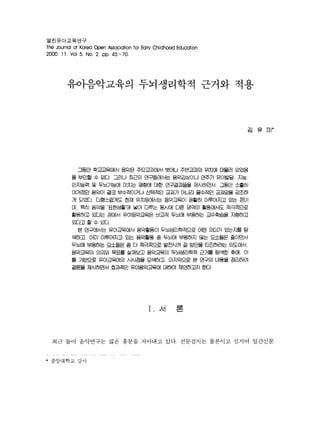
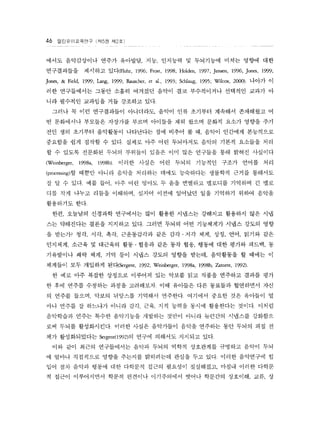
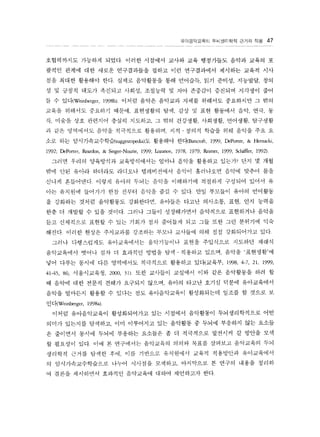
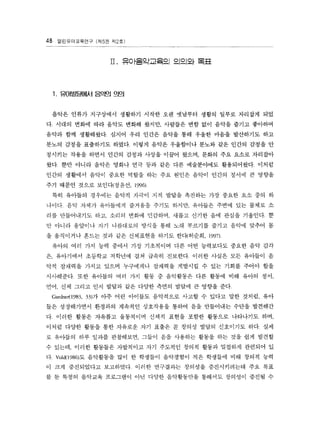
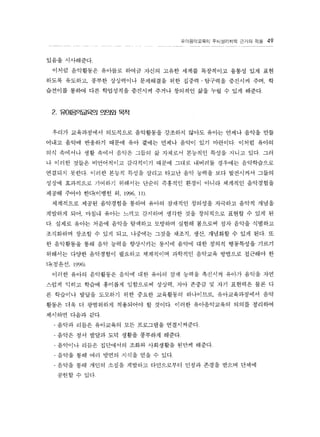
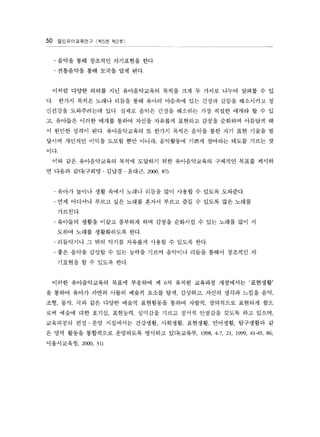

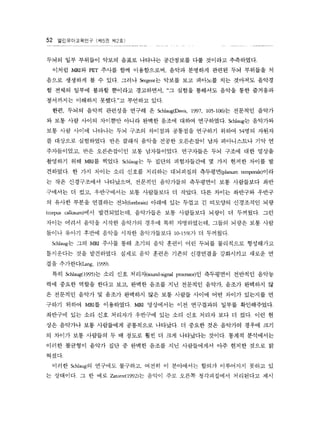
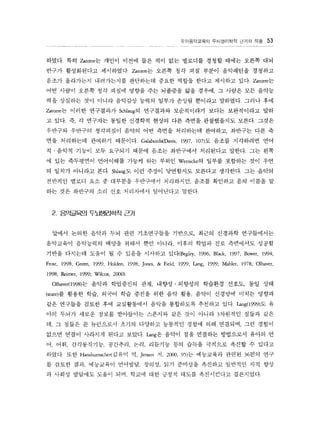
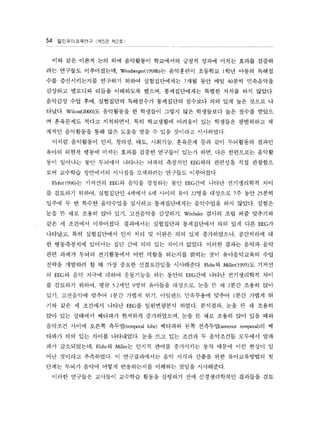
![??????? ?????? ??? ?? 55
???? ??? ??? ???? ???? ??? ???? ??? ??? ??? ???
??.
??£¬ ??? ¡°???? ??¡±? ??? Rauscher( 1993) ?? ????? ? ??? ???
?? ??£¬ ?? ??? ??????? ??? ?? ???? ??? ??? ?????
¡°??? ??? D??¡±? ???. Rauscher ?? 10?? ??? ?? ?? ?????? ?
? ??? ???? ??? ????? ?????? ????? ??? Steele( 1999b)?
Rauscher ?? ¡±???? ??¡±? ????? ????? ???? ??????? ????
? ???? Steele? ????? ??? ??? ?? ??? ??? ???? ??? ??
?? ??? ?? 10?? ????? ??? ????? ????? ????? ????
???? ?? ???? ??. ??? ??? ??? ]ones(l999)?£¬ Rauscher ?1993)? ??
??? ????? ???? ??? 10? ?? ????? ?????? ??? ??? ?
????? ???? St¦Åel? 1999b)? ?????? ?? ??? ???? ?? ???£¬ ? ?
??? ??? ? ?? ????? ???? ?????£¬ ???? ?? ??? ??? ??
? ??????£¬ ??? ??? ??? ??? ????? ????? ??? ????1 ?
??? ??? ??? ??? ???? ???? ???? ??.
Steele? ??? ???£¬ ¡°???? ??¡±? ???? ??? ??? ??? ????£¬ ??
? ?? ???? ???? ?? ????? ???? ??? ??? ???? ??? ??
?£¬ ?? ?? ??????? ?? ?????? ??? ??? ??? ??¡´????£¬
]ensen?£¬ 2000, 93). ??? ?? ????? ??? Dougl? ????? ???? ? ???
??? ??? ?? ?? ? ?? ???? 20 ? ?? ??? ????£¬Th¦Ábury£¬ Ointon, ?
?? Fair Avenue? ?? ??? ?? ???? ??? ?????? ????? ??? ?
?? ????{]ensen£¬ 1998, 38-39)
?? Black( 1997)? ????? ????? ??? ??? ??? ????? ???? ?
??£¬ ?? ???£¬ ????? ???? ???£¬ ???£¬ ???£¬ ???£¬ ?? ??? ??
???? ?????? ???? ??? ??? ??? ???? ???? ?? ?????
????? ?? ??? ?? ???? ??? ??? ??? ????? ??? ??
Black? ??? ????? ??? ??? ??? ???? ?? ???? ??? ????
? ?? ????? ??? ??? ??? ???
??? ??? ????? ?? ???? ??? ??? ??? ????9 ??? ???
? ??£¬ ??? ????£¬ ??? ??? ???? ???? ?? ? ?? ??? ???
???? ??? ??
??£¬ ?? (arous?)? ???? ???? ??? ??? ???? ??????? ????](https://image.slidesharecdn.com/95-140915112014-phpapp01/85/95-_-11-320.jpg)
![56 ???????? (? 15? ? 12 ?)
?? ?????. ? ?? ??? ??? ???? ??? ??? ?????? ?????
??? ?????? ?????£¬ ????? ???? ??? ???? ??? ?????
? ???? ???? ??? ??? ? ?? ?? ??? ??? ???? ????? ?
?? ??t? ??£¬ ?? ?? ??? ??? ??t? ??DePorter£¬ & Hernacki, 1992, 256¡®
DePorter, Reardon, & Singer-Nourie, 1999, 75; Ostrander, Schr¡Şder£¬ & Ostrander, 1994, 80-81) ?
?? ??? ????? ??? ?? ??? ?? ??? ??????£¬ ????? ???
??? ?? ??? ?? ??? ??? ????? ???£¬ ??? ??? ???? ???
??? ?? ?? ???? ??? ?? ??? ?? ??? ??? ???? ???? ?
???? ??.
??£¬ ??? ????carrier)? ???? ?????? ?£¬ ]ensen ?£¬ 2000, 94; ]ensen,
1996, 221; Kline, 1988, 47). ? ??? ??? ???? ??? ???? ?? ??? ???
??. ??? ???? ??? ??? ??? ??? ?? ???? ? ?? ?? ???
??? ???? ??? ?? ?? ????? ??? ??? ??? ?? ?? ? ?J-??
?£¬ ??? ?? ? ? ??. ??? ????? ??? ??? ???? ??? ????
??? ???? ? ??? ?? ???? ?? ?? ? ??? ??? ??? ???? ?
?? ? ??? ??? ? ? ???? ?? ??? ?? ???? ???? ??? ???
?. ?? ??? ?? ??? ??? ??? ??? ? ¡°??? ?? ?¡±??? ??? ??
?? ??? ???? ???? ??? ¡°??? ?? 100?? ???¡±??? ??? ???
? ??? ??? ????? ??? ?? ? ? ??. ??? ??? ??? ????? ?
??? ?? ???? ???? ??? ? ??.
??£¬ ??? ?? ????? ???? ??? ??? ??? ????? ??? ? ?
? ??? ???? ?????£¬ ¡°?? ??¡±? ??? ??? ??? ??1 ?? ? ???
? ?? ??? ??? ? ? ???? ??? ?? ¡±??~trigger) ?? ??priming)"?? ??
??? ???? ?????? ?? ??????? ???? ???? ??? GABA? ?
? ??????? ???? ???? ???? ??? ?? ?? ????? ???£¬ ??
? ????? ??? ??? ??? ???? ?? GABA? ????£¬ ???? ?? ??
?? ??£¬ ???? ????? ??£¬ ??? ??£¬ ??? ??? ? ??? ??? ???
???? ?????? ??? ? ?? ??? ????? ?????{???£¬ 1998, 181).
??? ??? ????? ?????£¬ ?? ??? ??? ??? ?? ?? ??? ???
?? ??? ????? ?? ??
?? ??? ??? ? ?? ???? ?? ???? ??? ?? ?? ?? ??? ??
??? ???? ?? ?? ??? ??? ???? ?? ???? ??? ?? ????£¬](https://image.slidesharecdn.com/95-140915112014-phpapp01/85/95-_-12-320.jpg)

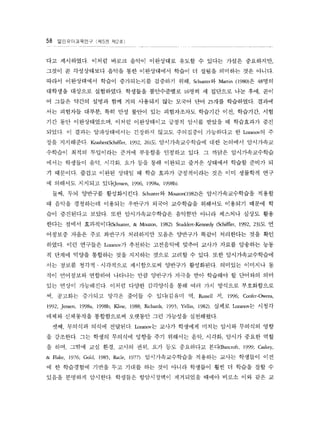
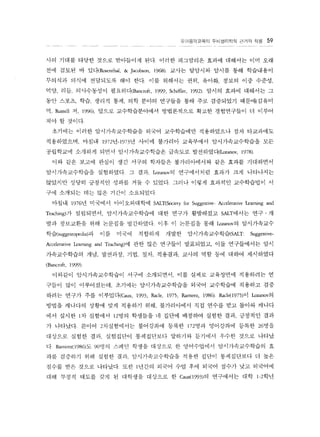
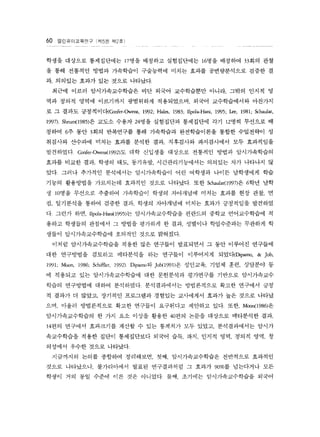
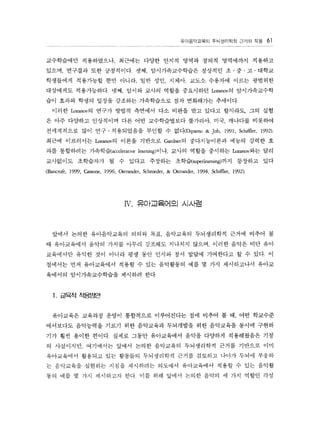
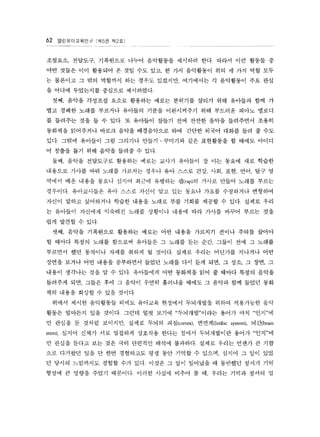
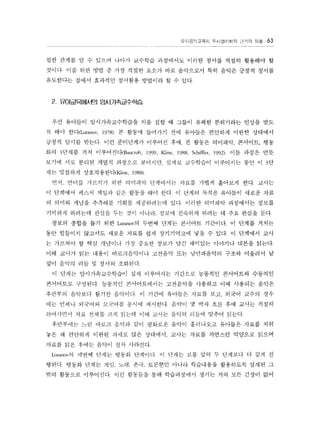

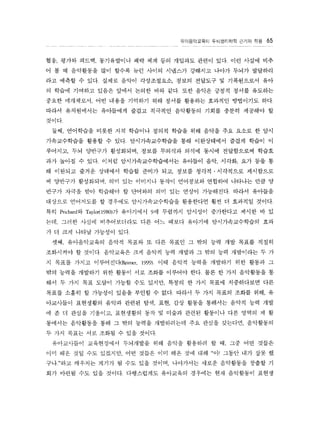
![66 ???????? (? 5? ? 2 ?)
?? ?? ???? ??? ?? ???? ????? ????? ?? ???£¬ ?????
? ??? ???? ??? ?????£¬ ????? ?? ??? ??? ? ?? ??? ?
??? ??? ??? ????? ??????? ???? ??? ??? ? ?? ???
¡¶????}
???-(1998) ??? ???? ??? ?? ? 1998-10?
??? 1999). ??? ???? ?? ?? ?????????
??? ¡¤ ??? ¡¤ ??? (2000) ?????? ??: ????
??? ?£¬ Russell, P.(996) ??? ?? ?? ?????¡®
??? (998)¡® ???? ?? ?? ?? ????£¬
??? ?£¬ Eric Jensen ? (2000) ?????? ??¡¤ ????
???????? (2¦ÁJO)¡® ????? ??? ???? ?? ¡¤ ?? ??
??? ? 3 ?(1 996) ?????? ?? ???
???(1 996) ??? ????? ??? ??? ??? ????? ??? ?? ????£¬ 5, 143-160.
???(1 997) ??? ??? ???? ??? ???? ???? ?? ??? ?? ????"£¬ 6,
150-167.
Bancroft, W. ].(1999). Suggestopedia and Language a??sition. N.Y.: Gordon & Breach Publishers
Begley, S.(1996). Your child's brain. E] 519 032.
Black, S.(1997) ?le musical mind. E] 537 554
Bower, B.(1994). Brain images reveal cerebral side of music. S¦Á£¬ en?£¬ 145, 260.
Caskey, 0. W., & Flake, M. H.(1976). Essentials of suggestopedia: A primer for practitioners. ED
119 063
Cassone, L.(996). Accelerared learning. hrrp://www.contexr.orgIIOlBIIC27/Labiosa.htm
Confer-Owens, V. A.(1992). Effectiveness of suggestive-accelerative learning tech?ques in teaching
underprepared college freshmen. ED 355 236
Caux, P. Y. M.(1993). Accelerated 1?rning in a beginning college-Ievel French course. Unpublished
Doctoral Dissertation. Houston: University of Houston
Davis, ].(1997). Mapping the mind. N.].: A Birch Lane Press B¡Şk
DePorter, B., & Hernacki, M.(1992). Quantum learning. New York: A Dell Trade Paperba¦Ék.
DePorter, B., Reardon, M., & Singer-Nourie, S.(999). Quantum teaching. Boston: Allyn and Bacon
Dipamo, B., & ]ob, R F. S.(199 1). A methodological review of srudies of salt techniques. Ausrralian](https://image.slidesharecdn.com/95-140915112014-phpapp01/85/95-_-22-320.jpg)
![??????? ?????? ??? ?? 67
Jo.¦É¦Ç¦Ì" 0./ ¦Å¨ªu¦É'atio.na! T.¦Êb¦Ço.!o.gy£¬ 7, 127-143
Flohr, W. ].(1996). ¦Álildren's elearophysiological responses to music. ED 410 017.
Flohr, ]. W., & Miller, D. C( 1995). Developmental quantitative EEG di?rences during psychomoror
response to music. ED4lO 016.
Frost, ]. L.( 1998). Neuroscience, play, and child development. ED 427 845.
Gardner, H. (983). Frames of nlind. New York: Basic B¡£?c5
Gold, L.(1985). Suggesto?dia: Activating the srudent¡¯5 reserve capacities. ED 328 057.
Green, F. R (l999). Brain and learning research: Implications for meeting the needs of divers¦Å l¦Åarners
¦Åiumtlon£¬ 119, 682-687
Hales, V. E( 1983). Suggestop¦Ådia: lts effecrs on word identif¨¬cation skills of nlildly and moderately
retarded children. Unpublish¦Åd Doctoral Dissertation. Texas Tech University
Hold¦Ån£¬ C(1998). Music ? f¦Áx:! for the brain. Scie¦Ç?. 282. 1409.
Ilpola-H?£¬ P.(l997). Suggestopedic language tea¦Éhing and its eValuation: The pupils' point of view
http://wwwlib.urni.com/dissertations/fullcit ' 1348865
]ensen, E.(l996). Brain-based learning. CA: Turning Point Publishing.
]ensen, E.(l998a). Introduaion to brain-compatible learning. CA ¡® The Brain Store, Inc.
]ensen, E.(1998b). Teaching with the brain in nlind. Virginia¡® Association for Supervision ?d
Curriculwn Development
]ones, R(999). Mozart's nice but doesn't increase IQs. http://cnn.com/l-?ALTH/ 9908/25/mozart.iq
jindex.html
]ones, N. A., & Field, T.(999). Massage and music therapies attenuate frontal EEG asymmetry in
depressed adolescents. A¦É'o!es?¦Ç'ce£¬ 34, 529-534
Kline, P.(1988) ?le ¦Åvery day genius. Virginia: Great Ocean Publishers.
Lang, S. S.(1999). Music-good for not only the soul, but the brain. Hwnan Ecology Forrnn, 27,
24-25
Lee, I. ].(981). Lstening comprehension: A combined strategy for accelerated learning. Unpublished
Doctoral Dissertation. Saint 1¦Ñuis University.
I¦Ñzanov£¬ G.(1978). Suggestology and out!ines of suggesro?dy. N.Y.: Gordon & Breach.
I¦Ñzanov£¬ G.( 1979). Accelerated learning and individual potenti?. E] 218 588.
Mahler, D( 1978). Music for learning. ED 158 543
M¡Şn £¬ C E.(1986). A meta analysis of suggesropedia, suggestology, suggestive- accelerative learning
and teaching, ?per-learning. ED 271 503](https://image.slidesharecdn.com/95-140915112014-phpapp01/85/95-_-23-320.jpg)
![68 ???????? (? 5? ? 12 ?)
OhIhaver, D.(l998). Learning with music in the classroom: What research says. EJ 574 195.
Ostrander, S., Schroeder, L., & Ostrander, N.(l994). Superlearning 2000. N.Y.: Delacorte Press
Prichard, A., & Taylor, ].(1980). Accelerating learning: Th¦Å use of suggestion in the classr¡Şm. c.A.:
Acadernic Therapy Publishers.
Racle, G. L.(l975). A teaching e?erience with the suggestopaedic method. ED 135 207.
Racle, G. L.(977). Suggestopaedia and the teaching of languages: Key points. ED 149 632
Ramirez, S. Z.(1986). The effects of suggesto?dia in teaching English vocabt?ary to Spanish-dorninant
chicano third graders. EJ 337 877.
Rauscher, F. H., Shaw, G. L., Levine, L. ]., Ky, K N., & Wright, E. L.(1993). Music ?d spatial
task performance. Nat¦É£¬ re£¬ 365, 611
R¦Åimer£¬ B.(1999). Facing the risks of the mozart effe¦Á . Phi Defta ¦Ê1ppa¦Ç£¬ " 81, 278-283.
Richards, R G. (1993). Learn: Playful techniques to accelerate learning. Arizona: Zephyr Press.
Rosenthal, R , & Jacobson, L.(1968). Pygmalion in the classr¡Şm. N.Y.: Holt, Rineharr, & W?nston.
Scha?at £¬ T. A.(997)¡® Effects of accelerated lear?ng methodology on student self-concept as acadernic
a¦Éhiev¦År. Unpublished Doctoral Dissertation. Saint 1¦Ñuis University
Schiffler, L.( 1992). Suggestopedic methods and applications. Pennsylvania: Gordon and Breach Science
Publishers.
SchIaug, G.(1995). ln vivo evidence of structural brain asymmetty in musicians. S¦Á£¬ e¦Ç¦Á" 267, 699-701
Schuster, D. H., & Marrin, D. ].(1980). ¦Ğle effects of biofeedback induced tension on rel?ation£¬
chronic anxiety, vocabulary easiness, suggestion and sense of subject on learning rare vocab?ary
words. Journa! of the 50¦Áe¦Ç ¦×rA¦Á'e!erative Lear¦Çn? ?? Teachi¦Ç![;£¬ 4, 275-288
Schuster, D. H., & Mouzon, D.(1 982). Music and vocabt?ary learning. Journal of the S¦Áiety for
Accelerative Learning and Teaching, 7, 82-108
Sergent, ].(1992). Distributed Neural Network Underlying Musical Sight-Reading and Keyboard
Performance. Science, 257, 106-109
Shrwn, H. E.(l985). A m?if¨¬ed instructional strategy for the accelarative and maste¦Ğ l?rning of
basic arithmetic by male incarcerated ad?ts. Unpublished Doctoral Dissertation. University of
Nevada
Steele, R (1999a). The Mozart effect: Fact or fantasy' hrtp: //www.earlychildh¡Şd. about.com/education/
earlychildh¡Ş¦Õlibrary/blnev.? htm.
Steele, R(1 999b). The Mozart effect: Fact or fantasy? hrtp://www.earlychildhood.about.com/education/
earlychildho?/library/blsteel¦Å htm.](https://image.slidesharecdn.com/95-140915112014-phpapp01/85/95-_-24-320.jpg)
![??????? ?????? ??? ?? 69
Vold, ]. N.(l986). A study of musical problem solving behavior in children and a comparison with
other aspects of creative behavior. Unpublished Doctoral Dissertation, Alabarna Universiry
Weinberger, N. M.(1998a). Brain, behavior, biology, and music: Some research findings and their
implications for educational policy. Arts ¦Åiucatio¦Ç Po/iry Re¦Áew£¬ 99, 28-36
Weinberger, N. M.(1998b) ¦Ğle music in our rninds. Educational Leadership, 56, 36-40
Wilcox, E.(2000, 2). Music, brain research, and better behavior. The ¦Å@¦É1f1O¦Ç Digl'.Jt, 65, 10-15.
Yellin, D.(1982). Left brain, right brain, su?r brain: 1be holistic model. ED 218 586
Zatorre, R ].(1992). Lateralization of Phonetic ?d Pit¦Æh Discrirnination in Speech Processing. S¦Á£¬ 'ence. £¬
256, 846-849.](https://image.slidesharecdn.com/95-140915112014-phpapp01/85/95-_-25-320.jpg)
